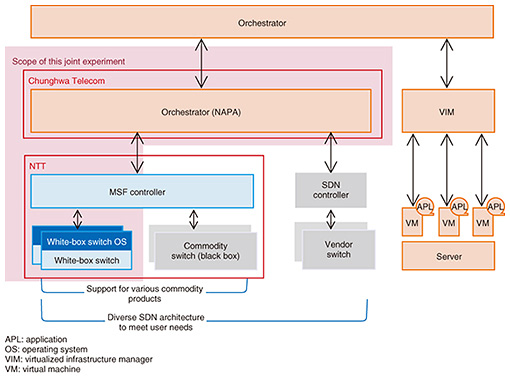 |
|
|
|
|
|
Short Reports Vol. 16, No. 5, pp. 51–52, May 2018. https://doi.org/10.53829/ntr201805sr1 Japan-Taiwan Joint Experiment Successfully Demonstrates White-box Based Carrier-grade Networking—International Service Provider Collaboration in Software-defined Networking Pushes Forward IP Packet Transport to Employ Commodity Products1. IntroductionNTT and Chunghwa Telecom succeeded in carrying out joint experiments in collaboration with ITOCHU Corporation and ITOCHU Techno-Solutions Corporation (CTC) to verify the service continuity and reliability required by telecommunications carriers for virtual network control. These experiments were made possible by the combination of NTT’s Multi-Service Fabric (MSF) and Chunghwa Telecom’s orchestrator called NAPA (Network Adapter with Programmability and Automation). MSF is technology for organizing white-box switches to work as an Internet protocol (IP) transport network. NAPA controls various products in response to user requirements. In 2015, the four companies began jointly studying software-defined networking and network functions virtualization (SDN/NFV) technologies with the aim of establishing network technologies to quickly respond to a wide range of needs with architecture that maximizes the use of commodity network products. The results of these experiments confirmed that highly reliable networks with high resistance to failure are possible by maximizing the functionality of white-box switches, which has led to further advances in studies on future application of white-box switches to commercial networks. 2. Background to joint experiments and history of cooperationIn recent years, carriers have not only been required to reduce costs but also to provide networks that can respond quickly and flexibly to the dramatic increase in traffic and to the growing diversification of network uses. In order to achieve this, it is becoming more important to utilize globally used common, generic technologies and products, rather than simply relying on traditional carrier network products. This has led NTT and Chunghwa Telecom to work on solving issues across wide areas of telecommunications carrier networks. Collaborative studies in the SDN/NFV fields began in September 2015 on IP packet transport SDN technologies and in April 2016 on NFV technologies. In February 2017, NTT, Chunghwa Telecom, ITOCHU, and CTC signed a memorandum of understanding (MoU) on joint research and experiments. The four companies agreed to focus on achieving commonization of SDN technologies to develop networks that will satisfy various needs and to proactively use generic network products (switches etc.) under this MoU. As part of the IP packet transport SDN technology studies that have been ongoing since the outset of this partnership, studies on white-box switch applicability for telecommunications carrier networks have been continuing, and the results of the joint experiments have successfully confirmed the applicability of these switches in the area of datacenter networks. Specifically, virtual network configuration and control technologies using white-box switches and white-box switch operating systems were verified by controlling MSF from NAPA (Fig. 1).
Simulations were carried out to confirm failures that were assumed to occur in telecommunications carrier network operations such as redundancy with controller failures and automatic communication route switching with white-box switch failures, and the simulation results indicated that the technology was reliable, which will enable service continuity. These experiments ran for two weeks in the Chunghwa Telecom Laboratories in Taoyuan City, Taiwan, and finished on December 1, 2017. ITOCHU supported the technical coordination and collaboration with Chunghwa Telecom and Taiwan manufacturers, while CTC provided white-box switch (hardware and software) integration support. For InquiriesPublic Relations, Planning Department, NTT Information Network Laboratory Group |
|









